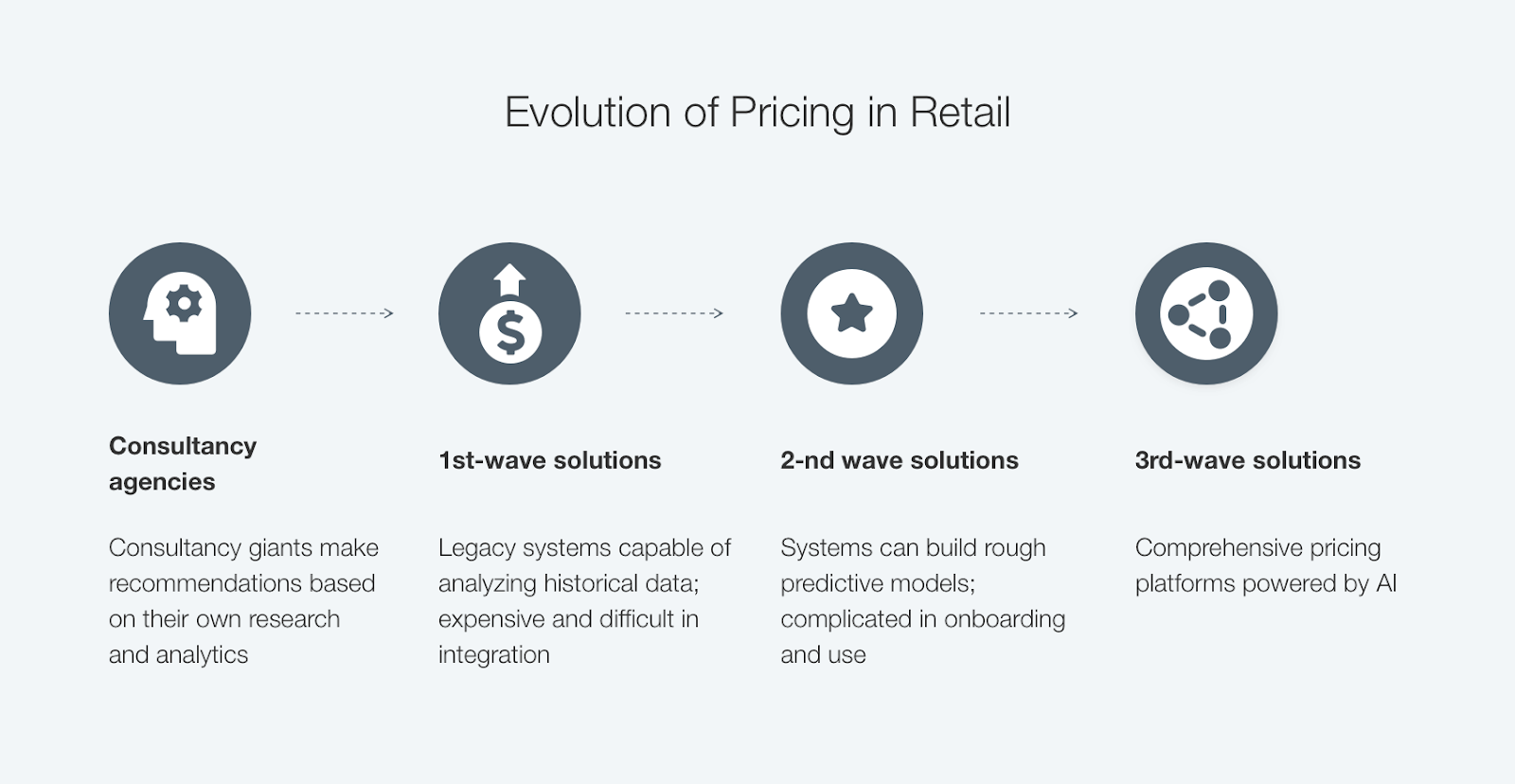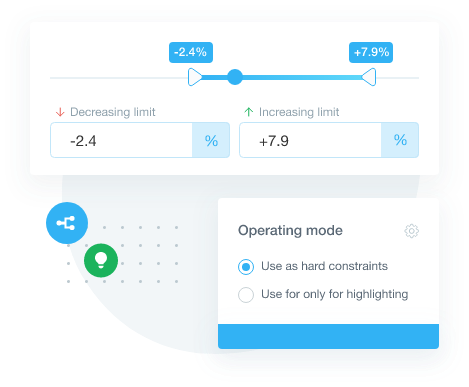Content navigation:
- Introduction
- What is a pricing engine?
- Pricing engine brings additional value to customers
- Pricing engine and the challenge of collusion
- The future of pricing engine: what comes next?
Introduction
IBM’s latest study found that more than 70% of retail and consumer products executives expect their business to get extensively engaged in intelligent automation across the value chain by 2021. But the problem is that pricing and product managers’ efficiency is still underinvested even though the price remains a major factor considered by shoppers.
The business value generated by pricing engine software is still to be unveiled by many retailers across the industries. Boost of the revenue, profit margin growth, and customer lifetime value (CLV) increase are only a few examples of benefits associated with the use of a pricing engine.
In this article, we're going to explore what dynamic pricing engine is and why retailers can no longer ignore advanced pricing engine solutions. We would also focus on the benefits and challenges associated with the pricing engine use in retail. Let's go right to business!
What is a pricing engine?
Pricing engine is a type of software used by retailers to process pricing and non-pricing data to craft optimal value offering on the portfolio level. It is an effective practical means used by retailers to upgrade their pricing policy. Dynamic engine helps to build a highly personalized shopping experience as pricing is diversified based on market trends, demand fluctuations, as well as customer behavior and purchasing power.
According to McKinsey, retailers tend to reprice the top-selling products three-four times per day, sometimes up to 12 times daily. Obviously, making repricing manually is not only time-consuming but also inefficient and vulnerable to mistakes. To manage pricing sustainably, retailers try various approaches from developing advanced math models in traditional spreadsheets to building complex in-house tech solutions.

Dynamic pricing engine represents a balanced and highly-effective alternative to the outlined above approaches. It does not substitute pricing managers but helps them to take the right decisions in a proactive way with no need to invest in resource-intensive in-house solutions.
Pricing engine design depends on each retailer's goals, constraints, and business maturity level. The solution might comprise one or several modules. The typical ones include:
-
Long-tail module helps retailers set the optimal initial price based on the market insights
-
Elasticity module calculates the way and extent to which new prices might impact the demand
-
KVI module is used to evaluate each product's contribution to the overall consumer price perception
-
Competitive-response module suggests price changes based on the comprehensive market data and insights
-
Omnichannel module allows managing pricing within both online and offline channels
Each pricing engine software provider has own approach to the integration process. Without going too much into technical detail, here’s how it works with Competera. At first, retailer provides the historical sales data to be processed by the algorithm. After that, together with the client, Competera’s pricing architect analyzes retailer’s requests and business targets to design specific goals for the market test. Then, the solution architect comes in to set up all the technical parameters from overall workflow to specific constraints and customizations. The entire integration process takes up to 8 weeks, after which the retailer gets market test proven results and the first ready-to-use recommendations.
Pricing engine brings additional value to customers
On the one hand, pricing is an instrument of raising revenue and gaining additional profit for a retailer while, on the other hand, it also plays a decisive role in shaping customer experience. In this regard, price personalization represents a win-win approach as it helps to satisfy customer requests and, at the same time, achieve business goals.
Personalization is likely to become the decade's most game-changing trend in retail. Today, only 12% of marketers in the industry are satisfied with the level of personalization they offer to clients. And that’s where pricing engine software could help. The very price is integral, yet not a single element constituting a personalized offer. To craft optimal value offering, the dynamic pricing engine considers:
-
Price. The tech-driven transformations in retail made pricing fluctuant and dynamic. Now, the prices across retail stores might vary depending on the sales channel, store’s location or other factors.
-
Promo. Just like prices, promo conditions are not stable being diversified across the retail stores or sales channel. Different promotions could be classified into several major types: ‘Buy One Get One’ (BOGO) promo, tiered promotion, ‘percent off’ discount, and others.
-
Special offers. In most cases, these refer to the long-term benefits for customers like, for example, participating in loyalty programs.
-
Markdown optimization. Permanent price reduction is a common practice in stock management. The process might create additional pressure on business and that’s why markdown optimization should be thoroughly considered while setting prices on portfolio level.
Advanced ML algorithms enable pricing engines to process dozens of factors and billions of pricing scenarios to provide shoppers with an optimal price with added value.
Pricing engine and the challenge of collusion
As pricing engines are becoming commonplace in retail, the concerns about the technology’s drawbacks also increase. One of the most drastic challenges associated with a dynamic pricing engine stems from the fact that some of the solutions may quickly learn to collude.
A recent study by researchers from the University of Bologna has shown that the autonomous pricing engines might learn to respond to one another’s pricing decisions in a negative way. In particular, the colluded engines may pull prices above the level where it could have been in case each engine would have operated alone.
The challenges outlined in the research referred to the pricing engines based on the use of reinforcement learning technology. Subsequently, a choice of the right tech solution capable to identify potential issues before they become problems is the first step to mitigate the risks of collusion.
Pricing engine software vendors propose various approaches to overcome the challenge of collusion. At Competera, we use a two-stage machine learning approach to mitigate the risks. Firstly, the engine calculates the precise effect of price changes on sales. Then, on the second stage, the complex price optimization algorithm processes the results of the first stage to recommend prices on the portfolio level.
The neural networks of the latest generation ensure the level of accuracy and reliability unreachable for traditional pricing approaches. Just one example to illustrate the difference between human-centric and tech-driven pricing: Competera's pricing engine processes up to 60 pricing and non-pricing factors at once, while an average manager can consider no more than 3 factors.
 Competera’s pricing constraints module
Competera’s pricing constraints module
Competera’s price management solution enables market players to keep all pricing constraints under control. For example, an increasing and decreasing limit for price change could be set and controlled by the user. This feature helps to undermine the risk of collusions and price wars completely.
The future of pricing engine: what comes next?
The recent study by Capgemini shows that retail executives expect AI to save as much as 340$ billion annually and advanced pricing software is among the most powerful sources of profit increase. After we’ve explained how pricing engine works, you might reasonably ask for real-life proves and numbers. Here they are: a leading Eastern European apparel retailer Intertop reached the point of 10.3% gross profit saving along with 200 BPS of profit margin saving after only 6 weeks of using Competera’s pricing engine. To find more evidence, explore the case studies section on our website.
The retailers using traditional and market-driven approaches to pricing are already facing substantial problems in keeping up with the competition. We believe that the future belongs to proactive rule-based pricing and comprehensive price optimization. The latter means shifting to portfolio-level pricing with goal-driven scenarios based on ML/AI models and automated pricing.
Pricing engine software brings sustainability to retailers of any size, maturity or industry. Try our market test to find what benefits can optimal prices bring to your business!
FAQ
Pricing engine uses advanced ML algorithms to calculate optimal prices based on particular business goals set as well as parameters and restrictions imposed by a user.
Dynamic pricing helps retailers to provide consumers with a highly personalized shopping experience as pricing is diversified based on market trends, demand fluctuations, as well as customer behavior, and purchasing power.






